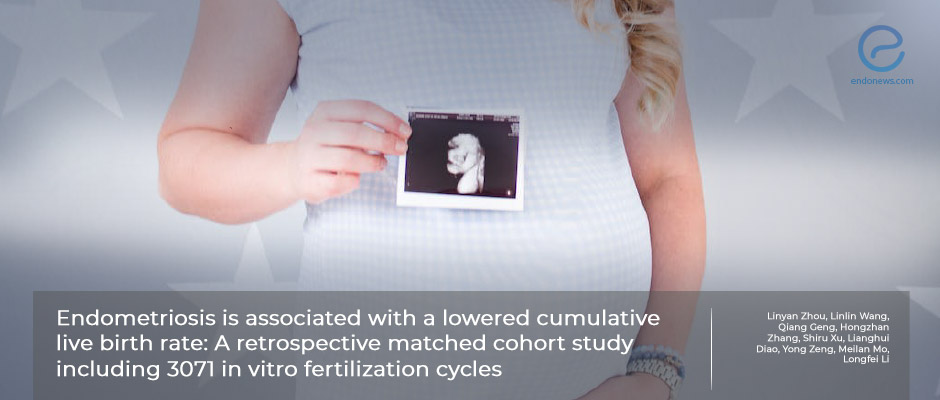Endometriosis and the cumulative live birth rate in IVF cycles.
Oct 25, 2022
Presence of endometriosis decreases the cumulative live birth rate, especially in younger women with frozen cycles.
Key Points
Highlights:
- Endometriosis has a negative impact on pregnancy success in IVF treatment, especially in young women: it adversely affects oocyte and embryo quality.
Importance:
- Women with endometriosis-associated infertility should be informed about the negative effect of the disease on IVF outcomes.
What’s done here?
- This retrospective study was conducted to evaluate the impact of endometriosis on in vitro fertilization (IVF) outcomes and the follicular microenvironment.
- Patients having surgically confirmed endometriosis (study group) and those with tubal factor infertility (control group) were enrolled.
- All patients were <45 years and nulliparous at the first attempt of IVF treatment.
- Of the 65 patients, the polarization stage of macrophages and cytokine levels depending on the cell number and follicular fluid volume were evaluated.
- Luteal phase downregulation protocol with a gonadotropin-releasing hormone agonist was applied in all participants.
- Clinical pregnancy, miscarriage, live birth, and cumulative live birth rates were assessed as the primary outcomes.
- In addition, the metaphase II (MII) oocyte rate, the 2 pronuclei (2PN) rate, and the percentage of high-quality embryos were also compared.
Key results:
- There was no significant difference between the endometriosis and tubal factor infertility groups (age, basal FSH level, BMI, antral follicle count, infertility, and endometrial thickness).
- Starting gonadotropin dose was higher in the endometriosis group although the total gonadotropin dose was comparable between the groups.
- Fewer oocytes and MII oocytes were retrieved significantly from endometriosis patients with a lower oocyte maturity rate.
- Fertilization and 2PN rates were similar between the groups.
- Although clinical pregnancy, miscarriage, and live birth rates in women with fresh cycles were the same, the live birth rate was significantly lower in the endometriosis group with frozen embryo transfer.
- Endometriosis was found the significant factor for decreased cumulative live birth rate according to logistic regression analysis.
- This significantly reduced the cumulative live birth rate was evident in younger women before 35 years of age with frozen cycles.
- Type I and type II macrophages and the cytokine levels in follicular fluid were significantly higher in the endometriosis group.
Strengths and Limitations:
- Macrophage and cytokine analysis in follicular fluid and comparing IVF outcomes between women with endometriosis and tubal factor infertility is the main strength.
- Retrospective and monocentric design, and the probability of the presence of endometriosis in the control group are the limitations.
Lay Summary
Infertility is one of the symptoms encountered in up to 40-50% of women with endometriosis. There are several pathophysiological theories suggesting the development of endometriosis-associated infertility. Assisted reproductive technology (ART) using in vitro fertilization and embryo transfer (IVF-ET) has been accepted as the most effective treatment modality for these women. However, the effect of endometriosis on IVF outcomes has not been fully elucidated.
Zhou et al, from China, published a study titled “Endometriosis is associated with a lowered cumulative live birth rate: A retrospective matched cohort study including 3071 in vitro fertilization cycles” in the journal named Journal of Reproductive Immunology. The authors aimed to evaluate the impact of endometriosis on pregnancy outcomes following IVF treatment. They also investigated whether there was a microenvironmental change in the follicular fluid of women having endometriosis compared with those having tubal factor infertility.
The study population consisted of patients with endometriosis and tubal factor infertility. There was no significant difference between the groups regarding demographic and clinical characteristics. Fewer oocytes and MII oocytes were retrieved significantly from endometriosis patients with a lower oocyte maturity rate. Fertilization and 2PN rates did not show a significant difference between the groups despite fewer high-quality embryos.
Although no significant difference was detected regarding clinical pregnancy, miscarriage, and live birth rates in women with fresh cycles, the live birth rate was significantly lower in the endometriosis group with frozen embryo transfer resulting in a lower cumulative live birth rate, especially in younger women.
When cytokine and macrophage typing analysis was performed, the numbers of type I and type II macrophages and the levels of cytokines in follicular fluid were also significantly higher in the endometriosis group. The increased concentrations of cytokines and chemokines were negatively correlated with IVF outcomes regarding embryo outcomes, the number of total oocytes retrieved, mature oocytes, fertilized oocytes, and the number of high-quality blastocysts and embryos.
“Women with endometriosis produce a lower quantity of oocytes and embryos, including top-quality embryos, and consequently exhibit reduced CLBR, which, in particular, is more significant in young women,” they added.
Research Source: https://pubmed.ncbi.nlm.nih.gov/35504114/
endometriosis in vitro fertilization cumulative live birth rate cytokine chemokine macrophage

